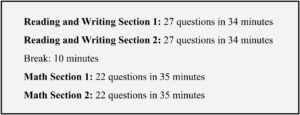Beginning in March 2024, the Scholastic Aptitude Test (SAT), administered by the College Board, is shifting its testing format from a paper exam to a fully digital program. With these shifts, the College Board hopes to lessen students’ stress before and during their experiences with the exam. Will these upcoming changes actually benefit students, or are they solely rooted in the economical benefits for the College Board?
The College Board claims they are shifting to a fully digital exam in order to create a more equitable experience for all test takers. According to IVY Scholars, a leading educational consultant and academic review, the new exam will last approximately two hours instead of its previous three hours in order to create a less stressful environment for students. The Chief Executive Officer (CEO) of the College Board, David Coleman, told The New York Times that historically the SAT has given students, “too much to cover and not enough time to do it.”
With this new exam, about 97% of students complete all the questions in a given section with up to seven minutes to spare. “It’s time we stop confusing quick with smart,” Coleman said. Additionally, the College Board is currently working with the Federal Communications Commission (FCC) on their Emergency Broadband Benefit program in order to provide internet access for all testing centers to sufficiently proctor the exam.
Regardless of the College Board’s advertised reasoning, “At the end of the day, the College Board is a business first and foremost.”Krista Klein, LWHS’s Co-Director of College Counseling said,
Throughout the heart of the COVID-19 pandemic in 2020 and 2021, about 1,600 colleges and universities chose to temporarily adopt “test-optional” policies, no longer requiring their applicants to submit standardized test scores. Consequently, as of September 30, 2020, the Educational Testing Service, which administers the SAT, saw their operating revenue fall over 22%, from nearly $1.36 million to $1.05 million. As of December 31, 2020, the College Board, which creates the SAT, saw their operating revenue fall by over 27%, from approximately $1.06 million to roughly $770,800. Throughout 2021-2023, over 1,800 four-year colleges have adopted indefinite or permanent test-optional policies.
Until the announcement of their digital test, the College Board was projected to continue losing revenue each year. However, according to Education Next, an academic news resource, since the announcement, the College Board’s revenue for 2024 is projected to completely bounce back, regardless of the ongoing test-optional policies, because more students will have access to the exam, and the exam will also be cheaper to administer. With this shift, the number of canceled tests is calculated to drop, and student’s access to the exam is also projected to rise. This will ultimately result in more students taking the exam leading to an increase in profit for the College Board.
Regardless of the College Board’s motivations in redesigning the exam, over one million students are still projected to take the test online in 2024. Therefore, what’s most important to many educators and families is the effects of this new exam on students.
Although the new exam is not scheduled to be released until the 2024 spring testing season, there are a few known changes set to affect all students. The first, is the previously mentioned shortened length of the exam. The new digital exam is set to be slightly over two hours—instead of the previous three hours—excluding a break midway. The breakdown is as follows:

Additionally, the second section of each subject in the new exam is programmed to be adaptive based on a student’s scores from the previous section. Using a new technology, the second section will present more or less challenging questions to students based on their success with the first section. For example, if a student answers the majority of the questions in section 1 correctly, their second section in that subject will be more challenging than a student who did poorly in their first section of the same material. With this new system, the College Board aims to more precisely determine a student’s knowledge, in order to craft scores that more accurately express the student’s academic standing in relation to others.
This new testing technology is unknown to many students and is consequently frightening. For LWHS student Leah Lashinsky ’25, the new adaptive sections feel daunting. “It’s difficult to prepare for an exam style you know little about and that you’ve never experienced before,” Lashinsky said.
Additionally, Lashinsky shared her confusion about how the exam will be scored as a result of this new technology. However, the College Board has assured students that its algorithms have assigned different weights to questions, so more challenging problems are proportionally weighted against those considered simpler.
The third significant change in the upcoming exam is the new implementation of Desmos, a digital graphing calculator, into the exam system. As of March 2024, students will have access to the powerful calculator on all math questions where calculators are allowed.
Asa DeZerega ’25 believes that the inclusion of Desmos has the potential to be a game changer for SAT takers. Although the LWHS junior hasn’t taken the SAT yet, he was able to take a digital PSAT in early September. On the PSAT, DeZerega had access to Desmos, and said, “[the application] was extremely helpful in getting answers out quickly, which was really important on the PSAT, and I imagine also on the SAT.” With access to Desmos, in addition to the reduced test length, DeZerega believes the SAT will be easier than in previous years.
Beyond the possibility of an easier exam, DeZerega also sees a deeper value in updating the SAT. “The world is constantly adapting, and therefore so should the SAT in order to most accurately reflect students’ education and experiences,” DeZerega said.
At the end of the day, Klein believes the relevance of standardized tests in college admissions is continuously diminishing, and as a result, test-optional applications have given students the ability to prioritize different aspects of their applications, such as their essays and personal statements. As of Fall 2023, the Universities of California and the California State Universities have permanently decided not to accept test scores as part of a student’s applications, and over hundreds of universities across the country have become test-optional.
“We start out telling every junior to begin testing with PSAT in order to see where you are with testing,” Klein said. “A lot of our students are really strong test takers, and if they’re applying to schools that take test scores, then we encourage them to go down that road. However it is becoming increasingly important for students to know that testing is not the end all be all of college admissions.”









Escort Gazette review guide with free verified ads in Europe. Best Escort Girls, Strip clubs, Brothels, Massage parlors on the map. Easy search directory. https://angeloxkxj69146.arwebo.com/49321584/escort-gazette-review-guide-with-free-verified-ads-in-europe
Escort Gazette review guide with free verified ads in Europe. Best Escort Girls, Strip clubs, Brothels, Massage parlors on the map. Easy search directory. https://neilv146eqc4.myparisblog.com/profile
Escort Gazette review guide with free verified ads in Europe. Best Escort Girls, Strip clubs, Brothels, Massage parlors on the map. Easy search directory. https://get-social-now.com/story2210339/escort-gazette-review-guide-with-free-verified-ads-in-europe
Escort Gazette review guide with free verified ads in Europe. Best Escort Girls, Strip clubs, Brothels, Massage parlors on the map. Easy search directory. https://titusmzmy25580.wiki-jp.com/631317/best_escort_girls_strip_clubs_brothels_massage_parlors_on_the_map_easy_search_directory
Escort Gazette review guide with free verified ads in Europe. Best Escort Girls, Strip clubs, Brothels, Massage parlors on the map. Easy search directory. https://waylonftfs02570.ageeksblog.com/25962100/best-escort-girls-strip-clubs-brothels-massage-parlors-on-the-map-easy-search-directory
Escort Gazette review guide with free verified ads in Europe. Best Escort Girls, Strip clubs, Brothels, Massage parlors on the map. Easy search directory. https://hypebookmarking.com/story16742664/best-escort-girls-strip-clubs-brothels-massage-parlors-on-the-map-easy-search-directory
Escort Gazette review guide with free verified ads in Europe. Best Escort Girls, Strip clubs, Brothels, Massage parlors on the map. Easy search directory. https://lukasaoaj69146.getblogs.net/58598973/best-escort-girls-strip-clubs-brothels-massage-parlors-on-the-map-easy-search-directory
Escort Gazette review guide with free verified ads in Europe. Best Escort Girls, Strip clubs, Brothels, Massage parlors on the map. Easy search directory. https://scotte469mwi6.blogsmine.com/profile
Escort Gazette review guide with free verified ads in Europe. Best Escort Girls, Strip clubs, Brothels, Massage parlors on the map. Easy search directory. https://hylistings.com/story17803718/escort-gazette-review-guide-with-free-verified-ads-in-europe
Escort Gazette review guide with free verified ads in Europe. Best Escort Girls, Strip clubs, Brothels, Massage parlors on the map. Easy search directory. https://elliotzmzm70257.spintheblog.com/26683211/best-escort-girls-strip-clubs-brothels-massage-parlors-on-the-map-easy-search-directory
Escort Gazette review guide with free verified ads in Europe. Best Escort Girls, Strip clubs, Brothels, Massage parlors on the map. Easy search directory. https://thetopdirectory.com/listings12681622/escort-gazette-review-guide-with-free-verified-ads-in-europe
Escort Gazette review guide with free verified ads in Europe. Best Escort Girls, Strip clubs, Brothels, Massage parlors on the map. Easy search directory. https://bullw147dpa3.wikitelevisions.com/user
Escort Gazette review guide with free verified ads in Europe. Best Escort Girls, Strip clubs, Brothels, Massage parlors on the map. Easy search directory. https://daltonviuh58035.shotblogs.com/escort-gazette-review-guide-with-free-verified-ads-in-europe-40224940
Escort Gazette review guide with free verified ads in Europe. Best Escort Girls, Strip clubs, Brothels, Massage parlors on the map. Easy search directory. https://bookmarknap.com/story6828398/best-escort-girls-strip-clubs-brothels-massage-parlors-on-the-map-easy-search-directory
Escort Gazette review guide with free verified ads in Europe. Best Escort Girls, Strip clubs, Brothels, Massage parlors on the map. Easy search directory. https://holdenobpb36813.dreamyblogs.com/26689811/best-escort-girls-strip-clubs-brothels-massage-parlors-on-the-map-easy-search-directory
6vr5cs